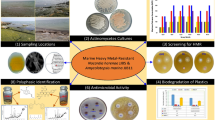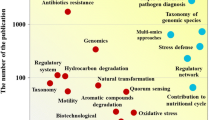Abstract—
Nontraditional sources were shown to be promising for obtaining bacterial isolates characterized by efficient production of antibiotics, including those affecting the strains with multidrug resistance. From Antarctic permafrost, 32 bacterial strains were isolated, and their ability to synthesize antimicrobal compounds efficient against 12 test strains, including the ones with multidrug resistance, was studied in submerged cultures. Out of 13 strains producing antibiotic compounds with different spectra of action, seven were chosen for further study. Their species identification was carried out by microbiological techniques and by analysis of their 16S rRNA gene sequences. Six strains of spore-forming bacteria were identified as Bacillus species (B. licheniformis, B. mojavensis, B. safensis, and B. subtilis), while one strain was identified as Gordonia terrae. Antimicrobial activity of two B. mojavensis strains (INA 01149 and INA 01151), two B. safensis strains (INA 01153 and INA 01154), and B. licheniformis strain INA 01155 against the antibiotic-resistant tester strain Leuconostoc mesenteroides VKPM B-4177 (VR) was revealed. Antibiotic activity of two B. safensis strains (INA 01153 and INA 01154) against tester bacteria, including Pseudomonas aeruginosa ATCC 27853 and Staphylococcus aureus INA 00761 with multidrug resistance has not been reported previously. Antibiotic producers isolated from Antarctic permafrost samples are of interest to medicine due to the global issue of increasing antibiotic resistance of pathogenic bacteria.
Similar content being viewed by others
REFERENCES
Alvarez-Ordóñez, A., Begley, M., Clifford, T., Deasy, T., Considine, K., O’Connor, P., Ross, R.P., and Hill, C., Investigation of the antimicrobial activity of Bacillus licheniformis strains isolated from retail powdered infant milk formulae, Probiotics Antimicrob. Proteins, 2014, vol. 6, pp. 32–40.
Arenskötter, M., Bröker, D., and Steinbüchel, A., Biology of the metabolically diverse genus Gordonia, Appl. Environ. Microbiol., 2004, vol. 70, pp. 3195–3204.
Bérdy, J., Bioactive microbial metabolites, J. Antibiot., 2005, vol. 58, pp. 1–26.
Blaschke, A.J., Bender, J., Byington, C.L., Korgenski, K., Daly, J., Petti, C.A., Pavia, A.T., and Ampofo, K., Gordonia species: emerging pathogens in pediatric patients that are identified by 16S ribosomal RNA gene sequencing, Clin. Infect. Dis., 2007, vol. 45, pp. 483–486.
Boucher, H.W., Talbot, G.H., Bradley, J.S., Edwards, J.E., Gilbert, D., Rice, L.B., Scheld, M., Spellberg, B., and Bartlett, J., Bad Bugs, No Drugs: No ESKAPE!, Clin. Infect. Dis., 2009, vol. 48, pp. 1–12.
Butler, M.S., Blaskovich, M.A., and Cooper, M.A., Antibiotics in the clinical pipeline in 2013, J. Antibiot., 2013, vol. 66, pp. 571–591.
Butler, M.S., Blaskovich, M.A., and Cooper, M.A., Antibiotics in the clinical pipeline at the end of 2015, J. Antibiot., 2017, vol. 70, pp. 3–24.
D’Costa, V.M., King, C.E., Kalan, L., Morar, M., Sung, W.W.L., Schwarz, C., Froese, D., Zazula, G., Calmels, F., Debruyne, R., Golding, G.B., Poinar, H.N., and Wright, G.D., Antibiotic resistance is ancient, Nature, 2011, vol. 477, pp. 457–461.
Domingos, D.F., de Faria, A.F., de Souza Galaverna, R., Eberlin, M.N., Greenfield, P., Zucchi, T.D., Melo, I.S., Tran-Dinh, N., Midgley, D., and de Oliveira, V.M., Genomic and chemical insights into biosurfactant production by the mangrove-derived strain Bacillus safensis CCMA-560, Appl. Microbiol. Biotechnol., 2015, vol. 99, pp. 3155–3167.
Drancourt, M., Pelletier, J., Cherif, A.A., and Rault, D., Gordonia terrae central nervous system infection in immunocompetent patient, J. Clin. Microbiol., 1997, vol. 35, pp. 379–382.
Dusane, D.H., Damare, S.R., Nancharaiah, Y.V., Ramaiah, N., Venugopalan, V.P., Kumar, A.R., and Zinjarde, S.S., Disruption of microbial biofilms by an extracellular protein isolated from epibiotic tropical marine strain of Bacillus licheniformis, PLoS One, 2013, vol. 8. e64501.
Favaro, G., Bogialli, S., Di Gangi, I.M., Nigris, S., Baldan, E., Squartini, A., Pastore, P., and Baldan, B., Characterization of lipopeptides produced by Bacillus licheniformis using liquid chromatography with accurate tandem mass spectrometry, Rapid Commun. Mass Spectrom., 2016, vol. 30, pp. 2237–2252.
Fickers, P., Antibiotic compounds from Bacillus: why are they so amazing?, Am. J. Biochem. Biotechnol., 2012, vol. 8, pp. 40–46.
Gontang, E.A., Gaudêncio, S.P., Fenical, W., and Jensen, P.R., Sequence-based analysis of secondary-metabolite biosynthesis in marine actinobacteria, App. Env. Microbiol., 2010, vol. 76, pp. 2487–2499.
Graça, A.P., Bondoso, J., Gaspar, H., Xavier, J.R., Monteiro, M.C., de la Cruz, M., Oves-Costales, D., Vicente, F., and Lage, O.M., Antimicrobial activity of heterotrophic bacterial communities from the marine sponge Erylus discophorus (Astrophorida, Geodiidae), PLoS One, 2013, vol. 8. e78992.
He, L., Chen, W., and Liu, Y., Production and partial characterization of bacteriocin-like peptides by Bacillus licheniformis ZJU12, Microbiol. Res., 2006, vol. 161, pp. 321–326.
James, G., Universal bacterial identification by PCR and DNA sequencing of 16S rRNA gene, in PCR for Clinical Microbiology, Schuller, M., Sloots, T., James, G., Halliday, C., and Carter, I., Eds., Dordrecht: Springer, 2010, pp. 209–214.
Jasim, B., Sreelakshmi, S., Mathew, J., and Radhakrishnan, E.K., Identification of endophytic Bacillus mojavensis with highly specialized broad spectrum antibacterial activity, 3 Biotech., 2016, vol. 6, no. 2, p. 187. Kozhevin, P.A., Vinogradova, K.A., and Bulgakova, V.G., Environmental functions of antibiotics as “informobiotics,” Vestn. Mos. Univ., Ser. 17, no. 3, pp. 3–9.
Lai, C.C., Wang, C.Y., Liu, C.Y., Tan, C.K., Lin, S.H., Liao, C.H., Chou, C.H., Huang, Y.T., Lin, H.I., and Hsueh, P.R., Infections caused by Gordonia species at a medical centre in Taiwan, 1997 to 2008, Clin. Microbiol. Infect., 2010, vol. 16, pp. 1448–1453.
Lewis, K. and Shan, Y., Why tolerance invites resistance, Science, 2017, vol. 355, p. 796.
Levin, B.R., Baquero, F., Ankomah, P., and McCall, I.C., Phagocytes, antibiotics and self-limiting bacterial infections, Trends Microbiol., 2017, vol. 25, pp. 878–892.
Levin-Reisman, I., Ronin, I., Gefen, O., Braniss, I., Shoresh, N., and Balaban, N.Q., Antibiotic tolerance facilitates the evolution of resistance, Science, 2017, vol. 355, pp. 826–834.
Mikolasch, A., Hammer, E., and Schauer, F., Synthesis of imidazol-2-yl amino acids by using cells from alkane-oxidizing bacteria, Appl. Environ. Microbiol., 2003, vol. 69, pp. 1670–1679.
Petrova, M.A., Gorlenko, Zh.M., Soina, V.S., and Mindlin, S.Z., Association of the strA–strB genes with plasmids and transposons in the present-day bacteria and in bacterial strains from permafrost, Russ. J. Genet., 2008, vol. 44, pp. 1116–1120.
Petrova, M., Gorlenko, Z., and Mindlin, S., Molecular structure and translocation of a multiple antibiotic resistance region of a Psychrobacter psychrophilus permafrost strain, FEMS Microbiol. Lett., 2009, vol. 296, pp. 190–197.
Rivardo, F., Turner, R.J., Allegrone, G., Ceri, H., and Martinotti, M.G., Anti-adhesion activity of two biosurfactants produced by Bacillus spp. prevents biofilm formation of human bacterial pathogens, Appl. Microbiol. Biotechnol., 2009, vol. 83, pp. 541–553.
Shternshis, M.V., Belyaev, A.A., Tsvetkova, V.P., and Shpatova, T.V., Biopreparaty na osnove bakterii roda Bacillus dlya upravleniya zdorov’em rastenii (Bacillus-Based Biopreparations for Regulation of Plant Health), Novosibirsk: Sib. Otd. RAS, 2016.
Sowani, H., Kulkarni, M., and Zinjarde, S., An insight into the ecology, diversity and adaptations of Gordonia species, Crit. Rev. Microbiol., 2017, vol. 25, pp. 1–21.
Stackebrandt, E., Rainey, F.A., and Ward-Rainey, N.L., Proposal for a new hierarchic classification system, Actinobacteria classis nov., Int. J. Syst. Bacteriol., 1997, vol. 47, pp. 479–491.
Sumi, C.D., Yang, B.W., Yeo, I.C., and Hahm, Y.T., Antimicrobial peptides of the genus Bacillus: a new era for antibiotics, Can. J. Microbiol., 2015, vol. 61, pp. 93–103.
Sun, H., He, Y., Xiao, Q., Ye, R., and Tian, Y., Isolation, characterization, and antimicrobial activity of endophytic bacteria from Polygonum cuspidatum, Afr. J. Microbiol. Res., 2013, vol. 7, pp. 1496–1504.
Ventola, C.L., the antibiotic resistance crisis: part 1: causes and threats, P. T., 2015, vol. 40, pp. 277–283.
Vinogradova, K.A., Bulgakova, V.G., Polin, A.N., and Kozhevin, P.A., Microbial resistance to antibiotics: resistome, its volume, diversity, and development, Antibiot. Khimioterap., 2013, vol. 58, pp. 5–6.
Yakimov, M.M., Kröger, A., Slepak, T.N., Giuliano, L., Timmis, K.N., and Golyshin, P.N., A putative lichenysin A synthetase operon in Bacillus licheniformis: initial characterization, Biochim. Biophys. Acta, 1998, vol. 1399, no. 2–3, pp. 141–153.
Youcef-Ali, M., Kacem Chaouche, N., Dehimat, L., Bataiche, I., Kara Ali, M., Cawoy, H., and Thonart, P., Antifungal activity and bioactive compounds produced by Bacillus mojavensis and Bacillus subtilis, Afr. J. Microbiol. Res., 2014, vol. 8, pp. 476–484.
ACKNOWLEDGMENTS
This work was financially supported in part by the Russian Foundation for Basic Research, project no. 17-00-00393\17 of November 16, 2017.
Author information
Authors and Affiliations
Corresponding author
Additional information
Translated by D. Timchenko
Rights and permissions
About this article
Cite this article
Efimenko, T.A., Efremenkova, O.V., Demkina, E.V. et al. Bacteria Isolated from Antarctic Permafrost are Efficient Antibiotic Producers. Microbiology 87, 692–698 (2018). https://doi.org/10.1134/S0026261718050089
Received:
Published:
Issue Date:
DOI: https://doi.org/10.1134/S0026261718050089




